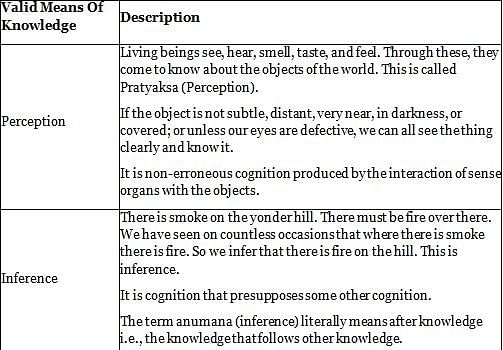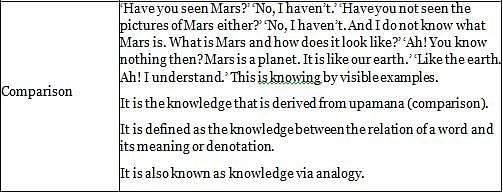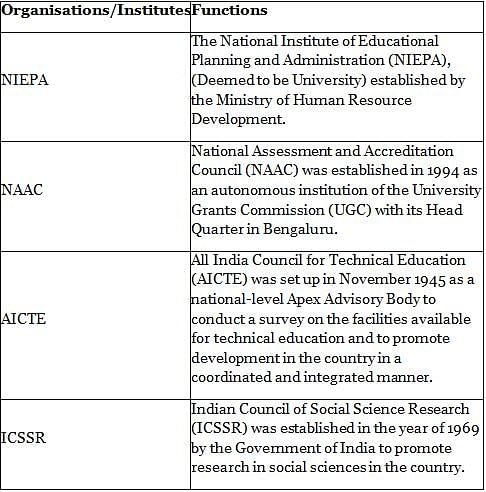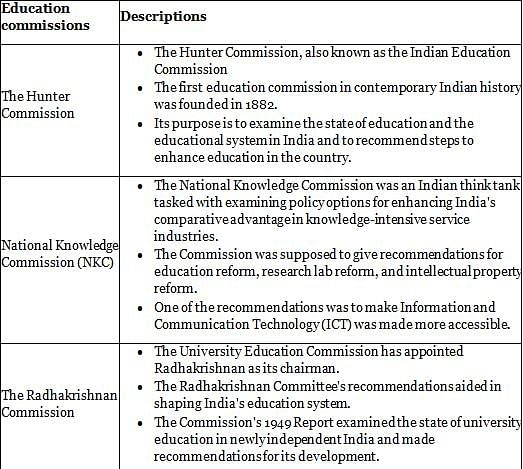MH SET Paper 1 Mock Test - 4 - MAHA TET MCQ
30 Questions MCQ Test MH SET Mock Test Series 2024 - MH SET Paper 1 Mock Test - 4
Identify the advantages of LED Monitor:
- It includes a broader dimming range.
- It is a more reliable monitor.
- It is often less expensive.
- It consumes less power (20 watts), and run on a lower temperature.
- It has a more dynamic contrast ratio.
Choose the correct answer from the options given below:
Organisational communication can also be equated with
| 1 Crore+ students have signed up on EduRev. Have you? Download the App |
Direction: Study the following line graphs and answer the given questions.
The graph shows the ratio of marks of History to Geography of 7 students in an examination.
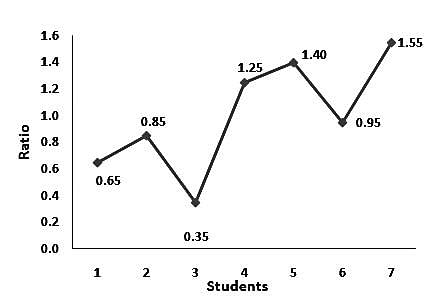
Q. Percentage increase of marks in Geography from student 3 to 4 is:
The graph shows the ratio of marks of History to Geography of 7 students in an examination.

Q. Percentage increase of marks in Geography from student 3 to 4 is:
Which of the following set of statements reflects the basic characteristics of teaching?
(A) Teaching is related to learning.
(B) Teaching is a ‘task’ word while learning is an ‘achievement’ word.
(C) One may teach without learning taking place.
If the salary of a person was first increased by 10% and later, the same was reduced by 10%, then the net change in his salary is
Which of the following statements is true in respect of computers?
Which of the following have the potential to trigger a tsunami?
1. Landslides
2. Volcanic eruptions
3. Glacial calving
4. Meteorite impact
Direction: Read the information carefully and answer the following question.
For a country, CO2 emission (million metric tons) from various sectors are given in the following table.

Q. By what percentage (\%\), the total emissions of CO2 have increased from 2005 to 2009?
If a cylinder has base radius of 6 cm and height 7 cm then find its volulme?
List I mentions the four valid means of knowledge as given by gotama while List II gives their description. Match List-I with List-II:
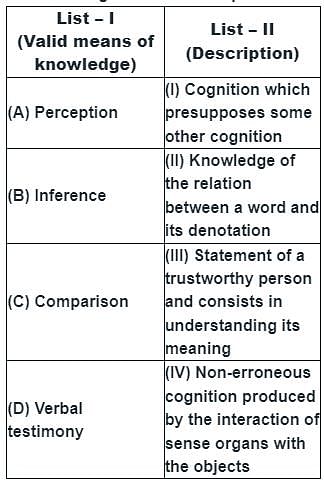
Choose the correct answer from the options given below:
System software is the set of programs that enables the computer’s hardware devices and _________ software to work together.
Which Telephonic Conferencing with a radio link is very popular throughout the world?
The statement - "We need to understand the importance of controlling our mind to tread the path that leads to Buddhahood" - is
The target set by the Indian government for generating power from wind energy by the year 2022 was
Which of the following initiatives has been implemented by MHRD under NMEICT Programme to incorporate Robotics into engineering education with the main objective of providing hands on application of Computer science, mathematics and engineering principles?
Which of the following factor(s) affect the process of teaching?
(i) Experience of a teacher
(ii) Subject matter of teaching
(iii) Classroom environment
(iv) Human relation skill
Match List I with List II

Choose the correct answer from the options given below:
Direction: Given below are two statements.
Statement I: Preadolescent children are unable to think abstractly or hypothetically.
Statement II: In the formal operational stage a child is able to use symbols related to abstract concepts.
In light of the above statements, choose the most appropriate answer from the options given below:
Direction: Read the following excerpt and answer the questions asked at the end. The answers to the questions should be based on the excerpt.
Although water covers approximately sixty seven percent of the Earth's surface, of this less than three percent is fresh water. Accounting for fresh water locked in glaciers, ice-caps or otherwise inaccessible, less than a tenth of a percent of the Earth's water is available for human consumption. Pollution, population growth and wasteful irrigation practices are contributing to a worldwide water shortage. When the clear precious liquid becomes scarce, countries begin to assert claims on fresh water supplies. As a result, drinkable water has become a region of conflict that could eventually lead to greater hostilities between nations.
Some countries such as the United States, have ample sources of water. In other nations, such as China, water is less plentiful. As water resources dwindle, competition for available sources will rise. Nations may claim rights to a particular body Of fresh water or they may plan to build dams and other projects on rivers. If two or more nations which disagree on water rights or building projects, conflicts can emerge. In order to combat this issue many countries are adopting water conservation and security solutions. The United Nations has implemented programs to combat potential issues that could lead to violence.
Q. Which of the following could be the probable reason for hostility among nations in the future?
Directions: In making decisions about an important question, it is desirable to be able to distinguish between 'strong' arguments and 'weak' arguments. 'Strong' arguments are those which are both important and directly related to the question. 'Weak' arguments are those which are of minor importance and also may not be directly related to the question or may be related to a trivial aspect of the question.
The given question is followed by arguments numbered I and II. You have to decide which of the arguments is/are 'strong' argument(s) and which is/are 'weak' argument(s) and mark your answer accordingly.
Should Indian government invest more time and resources to collect data, on the basis of which GDP (Gross Domestic Product) is calculated?
Arguments:
I. Yes, there is no good way yet to collect data from the hundreds of millions of establishments that constitute the production sector of our economy.
II. No, it would just take too long and cost too much, especially since much of the production sector of our economy keeps no records.
Match List I with List II

Choose the correct answer from the option given below:
A lecture without feedback from the students is ______.
Direction: Read the following passage carefully and answer the questions.
The Draft National Education Policy, 2019 (DNEP) implements the India-centric education system, which contributes to the continuous transformation of our nation into a just and vibrant knowledge society, by providing high-quality education to all. The NITI Aayog has focused policy focus specifically on education and outcomes of education from programs. It has promoted competitive federalism among states to improve their educational indicators that are measurable by a battery of tests on students. But any serious work on 'No One Left Behind' (NOLB) can ask for a new and reformist approach. DNEP has provided some hope, but it calls for further examination of rhetoric and reality.
DNEP must be read in the context of the current economic and educational climate in order to estimate the path and speed needed to make its vision a reality. On the one hand, we are in another new era of industrial revolution or skilled age. On the other hand, at present, around one million youth enter the workforce in India each month, but most of them are just raw hands without professional technical knowledge or practical business skills. The weak relationship between education and employment poses a potential risk of turning India's demographic dividend into a demographic disaster.
In the education sector, the elusive chaos of the quantity-quality-equity triangle remains unresolved. Although the merits of education are well recognized as an invaluable public, public investment for this has been minimal. It is relevant to explore how DNEP has addressed some key areas for policy interventions in school education, namely access, which can be measured by the education system, the size and flow of students crossing over to equity, which can be seen development-deprived populations, and lack or persistence of quality, which can be understood by teaching-learning processes and developmental outcomes for children that are more easily implied by attainable scores.
Q. What calls for further examination of rhetoric and reality?
Directions: In making decisions about an important question, it is desirable to be able to distinguish between 'strong' arguments and 'weak' arguments. 'Strong' arguments are those which are both important and directly related to the question. 'Weak' arguments are those which are of minor importance and also may not be directly related to the question or may be related to a trivial aspect of the question.
The given question is followed by arguments numbered I and II. You have to decide which of the arguments is/are 'strong' argument(s) and which is/are 'weak' argument(s) and mark your answer accordingly.
Q. Should there be a silver bullet solution for the 'Kashmir problem'?
Arguments:
I. No, there is not just one Kashmir problem in the country, but many, and each requires redressal by divergent means and at different stages.
II. No, there is a set of disparate problems of governance and of a communal, polarising and disruptive politics, each demanding a separate solution.
Which of the following are the fundamental duties of a citizen?
- Respect for the Constitution, the National Flag and the National Anthem
- To develop a scientific temper
- Respect for the Government
- To protect wildlife
Direction: Read the given passage and answer the questions that follow.
Early feminist theory had emphasised the commonalities of women's oppression, neglecting profound differences between women in terms of class, age, religion, race and nation. As its exclusionary nature became evident, the collective 'we' of feminism was called into question. The inadequacies of feminist theorising that conflated the condition of white, middle class women with the condition of all women were highlighted in North America by black and Latin feminists, and in Britain by black and Asian feminists. Such critiques evoked the concepts of 'inter‐locking identities' and inter‐locking oppressions'. Related and more radical analyses came from feminist scholars in the Third world, where quite different agendas were called for. These critiques heightened the irrelevance of western feminism's analytical frameworks to the lives of most women around the world and attempted to reposition feminist debate within broader social, economic and cultural contexts of analysis advocated by scholars such as Janus. Such critiques spoke from a post‐colonial position, in which the self‐assumed authority of western feminists to speak about or indeed for others was disputed and decentered. Influential accounts of the tendencies of masculinist imperialist ideological formation to construct a 'monolithic Third world' woman', discursively constituted as the universal victim of Third world patriarchy, challenged feminists to "unlearn" their privilege and to deconstruct their own authority as intellectuals. These positions appeared to question the legitimacy of outside intervention of any kind, whether intellectual or political. Although subsequently attempted by the Third world scholars anxious to move beyond standpoints that threatened to mark all feminist politics as either inauthentic or unnecessary, they were enduringly influential in highlighting the questions identity and authority in feminist studies.
Q. The passage speaks of:
Educational technology that has its origin in physical science and engineering:
a. Educational technology I
b. Educational Technology II
c. Hard approach
d. Soft approach
Select the correct answer from the code given below:
Which one of the following belongs to the category of homogeneous data?
Directions: The question is based on the following table.
DEMAND FOR GAS (Million Cubic meters/day)
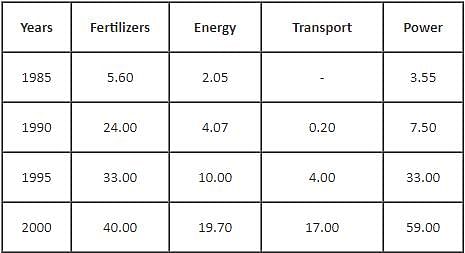
Q. From 1985 to 2000, which is the sector that has been experiencing roughly double the demand every five years?
|
60 tests
|







